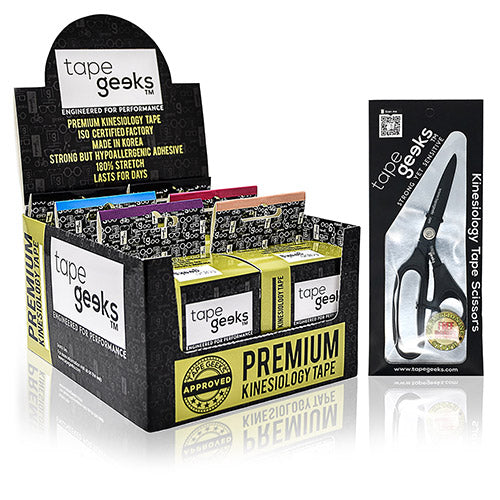
A calf strain is a type of muscle injury that occurs when the calf muscles are overstretched or torn.
Are you experiencing a calf strain?
In this article, we’ll talk about the causes of a calf strain, symptoms, and available treatments. We’ll also be talking about a kinesiology taping protocol that you can use to help give support for this type of calf injury.

Shop our kinesiology tape now
Shop NowWhat are the causes of calf strain?
Some of the most common causes of calf strain include:
- A sport that involves a lot of running, jumping, and quick direction changes
- Overuse
- Weak calf muscles
Some of the sports that make you prone to caf strain include football, tennis, baseball, rugby, and running.
What are the different grades of a calf strain?

Depending on the severity, calf strains can be graded on the following:
- Grade I calf strain. A grade I calf strain occurs when muscle fibers are partially stretched or a few are torn. When this happens, you can still walk normally and your leg’s range of motion is not limited. You may be required to take a break for 10-12 days before playing sports activities again.
- Grade II calf strain. A grade II calf strain occurs when some of the muscle fibers are moderately stretched or torn. You may feel the loss of strength in your leg and the area tender with pain. You may experience some bruising. You may also limp when walking. Your healthcare provider may require you to take a break for 16-21 days before playing sports again.
- Grade III calf strain. A grade III calf strain occurs when there is a severe tear in the muscle fibers and a complete muscle tear. A couple of hours from getting the injury, you’ll experience bruising and swelling. Putting some weight on the leg will feel very painful.
What are the symptoms of calf strain?
Here are the common symptoms of a calf strain:
- Sudden, sharp pain in the area
- Swelling
- Bruising
- Difficulty in walking
- Being unable to stand on the ball of your foot
How can a calf strain be diagnosed?
Here are the ways that your health care provider can diagnose a calf strain:
- Ultrasound
- Magnetic Resonance Imaging (MRI)
What is the difference between a calf strain and a tear?
When you have a calf strain, you may feel a sudden pain at the back of your lower leg. You may also feel a snap or a pop when the injury happens. When a severe calf tear happens, on the other hand, you may feel like you have been shot at the back of your leg.
How do you treat a calf strain?

Here are the available treatments for calf strain:
- Rest. Your healthcare provider may ask you to rest for a least a day or more. You may return to any of your daily physical activity when the pain and swelling go away.
- Applying ice. Applying ice to the area will help reduce swelling and inflammation. Apply ice no longer than 20 minutes since it may damage your skin.
- Heating pad. After 2 to 3 days of applying ice, you can alternate putting heating pads on the area. You shouldn’t leave the heating pad on your skin for too long as it may damage it.
- Bandages and/ or wraps. Putting a bandage or wrapping the calf may help with swelling and aid mobility.
- Kinesiology taping. Applying kinesiology tape to a calf strain will help give support to the area without limiting your range of motion.
- Over-the-counter pain medication. Over-the-counter pain medication like ibuprofen or acetaminophen may help with pain and swelling.
- Propping the leg above heart level. Putting the leg in an elevated position will help in reducing the swelling.

Shop our bundles now
Shop Now
How can kinesiology tape help with calf strain?
Before your application, here are some tips on how to prepare beforehand. Learn more about applying different kinesiology tape tensions. It's also good to learn about different kinesiology tape cuts.
Here are the steps in applying kinesiology tape for a calf strain to help alleviate the discomfort:
- Prepare three I strips - two long I-strips and one short. Make sure to round your edges.
- Anchor your tape on the base of your Achilles. Lunge forward to stretch your calf.
- Apply one long I-strip over the middle part of the calf with 0% tension.
- Take the second strip and apply it over the lateral calf with 0% tension.
- Next, take the short strip and give the tape 50% tension and apply it over the area with pain. Make sure to give the ends with 0% tension.
- Rub the tape to activate the adhesive.
Tape Geeks: The best skin-friendly kinesiology tape for calf strain

Shop our collection now
Shop NowWhen you’re using kinesiology tape to relieve discomfort from having a calf strain, it’s essential to consider the quality of the kin tape that you’ll be using for the sake of your skin!
Taping shouldn’t just be about muscle and joint support. It should also be protecting your skin from unwanted rashes and allergies that may be brought about by low-quality adhesives.
This is precisely what Tape Geeks is all about!
Get the best deals for Tape Geeks' products by visiting our Amazon store today!
How do you prevent calf strain?
There are several things you can do to help prevent calf strains, including:
- Stretching your calf muscles minutes before exercise and after
- Wearing supportive shoes with good arch support
- Avoiding sudden changes in direction or excessive jumping
- Strengthening your calf muscles with exercises like calf raises
Conclusion
That’s all for this article on calf strains. If you think you might have a calf strain, be sure to consult with a healthcare professional to get the correct diagnosis and treatment plan.
Be sure to check out our blog for more information on different aches and pains. We have a ton of information that can help you on the different kinesiology taping protocols that you can try for a variety of injuries like abdominal strain as well as golfer’s elbow.
Thanks for reading!

Shop our accessories and more
Shop Now
Subscribe to the TapeGeeks Newsletter for new videos, discounts and more!Join The Geeks Club









